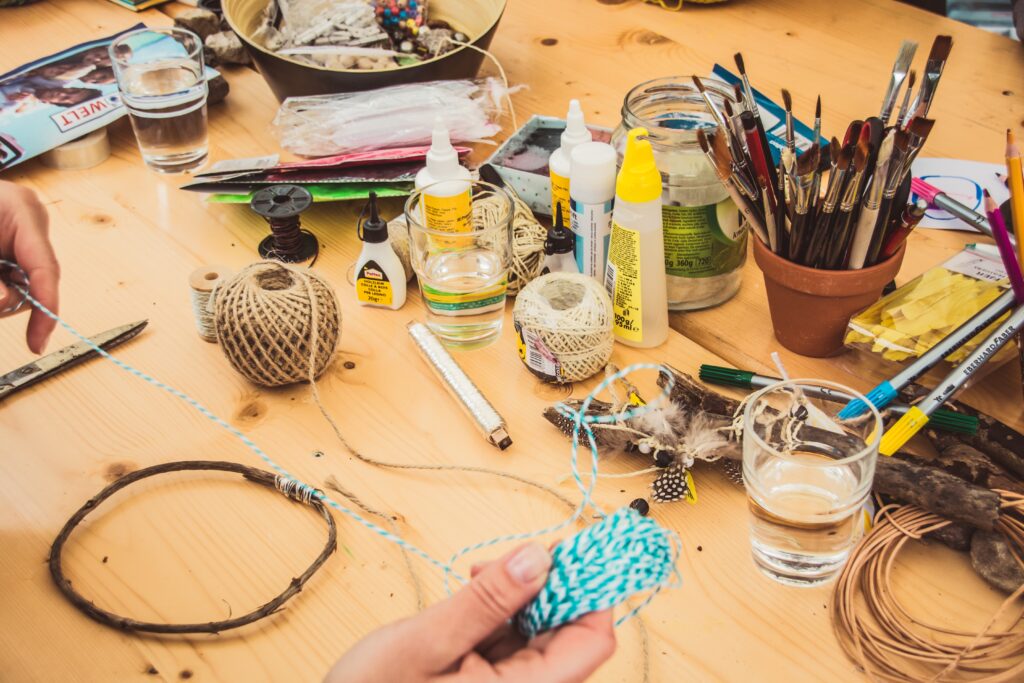Spray painting fake flowers is an excellent way to transform dull and lifeless artificial blooms into vibrant, eye-catching decorations. By following a few simple steps, you can effortlessly revitalize your faux floral arrangements, allowing them to perfectly complement any room or event. In this article, you will discover the expert guidance needed to achieve professional-looking results, even if you have no prior experience in this craft. From selecting the appropriate paint and color to applying it with precision, we will walk you through each stage of the process. Get ready to unleash your creativity and breathe new life into your artificial flowers.

This image is property of images.unsplash.com.
Materials Needed
To successfully spray paint fake flowers, you will need the following materials:
Spray paint
Choose spray paint specifically designed for use on plastic or fabric. Consider using a brand that offers a wide variety of colors to suit your creative vision.
Fake flowers
Select the fake flowers you wish to transform. Ensure they are made of materials that are suitable for spray painting, such as plastic or fabric. Avoid flowers with delicate or intricate details that may be damaged during the painting process.
Newspaper or drop cloth
To protect your working surface from paint overspray, lay down newspaper or a drop cloth. This will make the cleanup process much easier and prevent any accidental damage to your surfaces.
Masking tape
Use masking tape to cover any parts of the flowers that you do not wish to paint. This will help maintain clean lines and prevent paint from getting on unwanted areas.
Plastic gloves
Protect your hands from paint and chemicals by wearing plastic gloves throughout the painting process. This will also prevent paint from accidentally transferring onto your hands and smudging the flowers.
Spray primer
Applying a coat of spray primer before painting is optional but highly recommended. A primer will help the paint adhere better to the flowers, resulting in a smoother and more durable finish. Choose a primer specifically designed for use on the material of your fake flowers.
Spray varnish
To protect the painted flowers and add a glossy or matte finish, apply a coat of spray varnish. Varnish will help seal the paint and prevent it from chipping or fading over time. Select a varnish that is suitable for use on the material of your flowers and choose a finish that complements your desired look.
Preparing the Area
Before you begin spray painting your fake flowers, it is essential to prepare the area properly. This will ensure a smooth and efficient painting process.
Choose a well-ventilated area
Select a well-ventilated area such as an outdoor space or a well-ventilated room with open windows. Adequate ventilation is crucial to prevent the inhalation of paint fumes and to ensure the paint dries properly.
Cover the working surface
Place newspaper or a drop cloth over your working surface to protect it from paint overspray. The paint can easily drift in the air and settle on nearby surfaces, so covering the area will help prevent any accidental damage or stains.
Protect surrounding objects
Remove or cover any objects that are in close proximity to where you will be painting. This will prevent them from being accidentally painted and save you from potential cleanup and restoration efforts.
Preparing the Flowers
Before you begin painting the fake flowers, it’s crucial to properly prepare them. This step ensures that the paint adheres well and results in a professional-looking finish.
Clean the flowers
Wipe down the flowers with a clean cloth or use a mild soapy solution to remove any dust, dirt, or debris. Dry them thoroughly before proceeding to the next step. Cleaning the flowers ensures that the paint adheres properly and results in a smooth finish.
Remove any loose parts
Inspect the fake flowers and remove any loose or detachable parts, such as removable petals or leaves. This will prevent them from getting painted and make the painting process easier and more seamless.
Optional: Apply a coat of spray primer
Applying a coat of spray primer is an optional step but highly recommended. Primer helps create a smooth base for the paint and improves its adhesion. Follow the instructions on the primer can and apply a thin and even coat to the flowers. Allow the primer to dry completely before proceeding to the next step.
Applying the Base Color
Once the flowers are prepared, it’s time to apply the base color. The base color will serve as the foundation for the final look of the painted flowers.
Choose the base color
Select a spray paint color that best suits your desired aesthetic. Consider the color scheme you want to achieve and the purpose of the flowers. Whether you want vibrant and bold flowers or soft pastel tones, choose a base color that aligns with your vision.
Apply thin and even coats
Hold the spray paint can at a distance of about 6 to 8 inches from the flowers. Spray in a steady and sweeping motion, keeping the can in motion to prevent paint from pooling or dripping. Apply thin and even coats of paint, ensuring all surfaces of the flowers are covered. Avoid spraying too close as it can result in uneven coverage or drips.
Allow each coat to dry
Once you have applied the first coat of paint, allow it to dry completely before applying additional coats. Follow the instructions on the spray paint can for the recommended drying time. Applying coats of paint before the previous one is fully dry can result in a tacky finish and ruin the overall look.
Repeat as needed
Depending on the opacity and coverage you desire, you may need to apply multiple coats of paint. Repeat the process of applying thin and even coats, allowing each coat to dry before applying the next. Be patient and ensure each layer is fully dry before proceeding to the next step.

This image is property of images.unsplash.com.
Adding Details and Accents
To take your painted flowers to the next level, consider adding details and accents. This step allows you to personalize your flowers and make them truly unique.
Choose accent colors
Select additional spray paint colors that complement or contrast with your base color. These accent colors will be used to create patterns, gradients, or add depth to the painted flowers. Consider using colors that harmonize with your overall color scheme or experiment with unexpected combinations for a bold and eye-catching look.
Use stencils for patterns
To add intricate patterns or designs to your flowers, use stencils. Stencils are available in various shapes and patterns, allowing you to create stunning designs with ease. Secure the stencil of your choice over the flower and spray paint over it. Carefully remove the stencil to reveal the pattern. Allow the paint to dry before proceeding to the next step.
Create gradient effects
For a soft and blended look, you can create gradient effects on the flowers. Start by spraying a light coat of the accent color at the desired areas. Gradually build up the intensity by adding more layers of the accent color, slightly overlapping each layer. Blend the colors together smoothly for a seamless gradient effect.
Apply light layers for depth
To add depth and dimension to your painted flowers, apply light layers of accent colors over the base color. Focus on highlighting certain areas, such as the edges of petals or the center of the flower. Use a gentle and controlled spraying motion to avoid overpowering the base color. Experiment with different techniques to achieve the desired level of depth.
Drying and Sealing
After you have finished adding details and accents to your painted flowers, it’s time to let them dry and seal the paint for long-lasting results.
Let the paint dry completely
Ensure that the painted flowers are placed in a well-ventilated area and allow them to dry completely. Follow the instructions on the spray paint can for the recommended drying time. It is crucial to let the paint cure fully to prevent smudging or damaging the finish when handling or applying the varnish.
Apply a protective spray varnish
To protect the paint and add a glossy or matte finish, spray a coat of varnish over the painted flowers. Hold the can at a distance and apply a thin and even layer, making sure to cover all surfaces of the flowers. Varnish helps seal the paint and protects it from chipping, fading, or peeling over time.
Allow varnish to dry before handling
Once you have applied the varnish, allow it to dry completely before handling the flowers. Follow the instructions on the varnish can for the recommended drying time. Handling the flowers before the varnish has fully dried can result in smudges or fingerprints on the surface.

This image is property of images.unsplash.com.
Tips and Tricks
Here are some helpful tips and tricks to enhance your spray painting experience and achieve the best results:
Experiment with different techniques
Don’t be afraid to try out different techniques and styles when spray painting your fake flowers. Test different spraying distances, spraying angles, and paint layering techniques to explore various effects and create unique designs.
Use a toothpick or brush for fine details
When adding fine details or intricate accents to your flowers, a toothpick or small brush can be handy tools. Dip the toothpick or brush into the paint and carefully apply the details with precision. These tools allow you to achieve fine lines, dots, or small patterns that can elevate the overall look of the flowers.
Practice on a small test surface first
If you are new to spray painting or experimenting with a new color or technique, it’s advisable to practice on a small test surface first. This way, you can familiarize yourself with the spray pattern, coverage, and drying time before working on your main project. It’s always better to make mistakes on a small scale and learn from them.
Consider using gloss or matte finishes
Selecting the right finish for your painted flowers is essential to achieve the desired look. Consider whether a glossy or matte finish complements your overall aesthetic. Gloss finishes tend to make colors appear more vibrant and reflective, while matte finishes create a softer and more subtle appearance. Choose the finish that best enhances your project.
Common Mistakes to Avoid
Avoid these common mistakes to ensure a successful spray painting process:
Spraying too close to the flowers
One of the most common mistakes is spraying the paint too close to the flowers. This can result in uneven coverage, drips, or a textured finish. Maintain a distance of around 6 to 8 inches from the flowers and keep the can in motion while spraying to achieve a smooth and consistent application.
Applying thick coats of paint
Applying thick coats of paint at once may seem efficient, but it can cause the paint to pool, drip, or take longer to dry. Opt for thin and even coats, allowing each coat to dry completely before applying additional layers. Building up the color gradually ensures a more even and professional-looking finish.
Not allowing enough drying time
Rushing the drying process can lead to smudged or damaged paintwork. It is crucial to allow each layer of paint and varnish to dry fully before proceeding to the next step. Follow the manufacturer’s recommendations for drying times and be patient to achieve the best results.
Skipping the priming or varnishing steps
While priming and varnishing steps are optional, they play a crucial role in the longevity and appearance of the painted flowers. Skipping the priming step may result in poor paint adhesion and an inconsistent finish. Likewise, skipping the varnishing step can leave the paint susceptible to chipping, fading, or peeling. To ensure a professional and durable outcome, don’t skip these essential steps.

Alternative Methods
If spray painting is not your preferred method or you wish to explore other options, here are some alternative methods to consider:
Painting with a brush or sponge
Instead of using spray paint, you can opt to paint the fake flowers with a brush or sponge. Use acrylic or fabric paints and carefully apply the paint onto the flowers layer by layer. This method allows for more control over the application and is suitable for intricate designs or delicate flowers.
Dyeing fake flowers with fabric dye
For a vibrant and natural-looking transformation, consider dyeing the fake flowers with fabric dye. Dissolve the fabric dye in water according to the instructions and soak the flowers in the dye mixture. Leave them to absorb the color for the desired amount of time, then rinse and dry them. This method is particularly suitable for fabric flowers.
Using acrylic or fabric paints
If you prefer more control over the colors and textured effects, using acrylic or fabric paints is a great alternative. These paints allow for finer details and can be applied with small brushes or sponges. Experiment with layering colors, blending techniques, and adding textured effects to create unique and personalized painted flowers.
Conclusion
Spray painting fake flowers is a fantastic way to transform their appearance and add a touch of creativity to your space. By following the proper preparation steps, selecting the right materials, and implementing various techniques, you can achieve professional-looking results. Remember to take your time, practice on a small scale, and explore different color combinations and finishes to make your painted flowers truly unique. Enjoy the process and let your creativity bloom!




